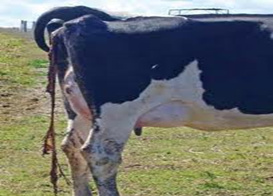Authors: Sonika Grewal1, Lamella Ojha1, Neha Sharma2, Nitin Raheja1, Aamrapali Bhimte1
1Ph.DScholar ICAR-NDRI, Karnal-132001, Haryana
2Ph.DScholar RAJUVAS, Bikaner, Rajasthan
INTRODUCTION
The incidence and importance of retained placenta (RP) varies greatly around the world. Retention of fetal membranes (RFM), or retained placenta, usually is defined as failure to expel fetal membranes within 24 hr after parturition. A retained placenta doesn't expel within a normal time limit. Generally, expulsion of fetal membrane occurs within 3-8 hr after calving. Retention of fetal membranes in cattle can lead to many ill effects on animal that ultimately affect reproductive and productive performance. According to many studied placenta may retain for 8 to 48 hours postpartum or 12 to 24 hours. The majority of cattle (66% in one study) will pass the placenta within 6 hours after parturition. There are three main types of retained placenta following the vagina delivery: placenta adherence (when there is failed contraction of the myometrium behind the placenta), trapped placenta (a detached placenta trapped behind a closed cervix) and partial accreta (when there is a small area of accreta preventing detachment) (Weeks ,2008).Therefore, Understanding about the pathophysiology and causative factors of RFM is important for managing this problem. The hormonal processes that lead to normal placental separation are multifactorial and begin before parturition.

| Prevention of retained placenta | |
| Causes | Prevention |
| Nutritional deficiency | Vitamin and mineral deficiencies can impair general immunity. Vitamin E (DL -tocopherol acetate, 1100 IU) and Se (sodium selenite, 30 mg) by single I/M injection, at 3 week prepartum, is used as a prophylactic dose to avoid placental retention in cows (Gupta et al., 2005) and also maintenance of Ca:P ratio of 1.5:1.0 and P supplementation |
| Metabolic diseases | Proper nutrition in peripartum period should be given to avoid metabolic diseases |
| Infectious diseases (Metritis or uterine infection) | To avoid infection proper immunization against specific infections should be done |
| Managemental stress | Transportation, rough handling, poor feed conditions results in elevated corticosteroids and increased risk of placental retention |
Retained placentas associated with many negative effects on animal body. Predisposing factors for retention of placenta include infectious diseases, managemental system, nutrition, hereditary, hormonal, immunosuppression, twining, still birth, cow’s body weight, calves’ birth weight, age, and parity. Cow with retained placenta have so many reproductive problems like higher incidence of metritis, increased calving interval, infertility and lower conception rates. Antibiotics therapy, Hormonal treatment, Nutritional management and Proper immunization reduces the incidence of retained placenta. Therefore, It is necessary to prevent Causative Factors to avoid retained placenta.
References
Hayirli A, RR Grummer, EV Nordheim, and PM Crump (2002). Animal and dietary factors affecting feed intake during the prefresh transition period in Holsteins. Dairy Sci, 85: 3430-3443.
Bolinder A, B Seguin and H Kindahl, (1988). Retained fetal membranes in cows: Manual removal versus non removal and its effect on reproductive performance. Theriogenology, l3: 45–56.
Gupta S, H Gupta and J Soni (2005). Effect of Vitamin E and selenium supplementation on concentrations of plasma cortisol and erythrocyte lipid peroxides and the incidence of retained fetal membranes in crossbred dairy cattle. Theriogenology, 64: 1273- 1286.
Youngquist RS and WR Threlfall, (2007). Current Therapy in large Animal Theriogenology, 2nd ed., Saunders, and imprint of Elsevier Inc, USA.
Drillich M, M Mahistedt, U Reichert, et al., (2006). Strategies to improve the therapy of retained fetal membranes in dairy cows. J Dairy Sci, 89: 627–635.
Weeks A D. (2008)The retained placenta .Best Practice & Research Clinical Obstetrics & Gynaecology, Volume 22, Issue 6, , pp. 1103-1117.
Joosten I, Sanders MF, Hensen EJ, (1991). Involvement of major histocompatibility complex class-1 compatibility between dam and calf in the etiology of bovine retained placenta. Animal Genetics 22:455-463.
About Author / Additional Info: